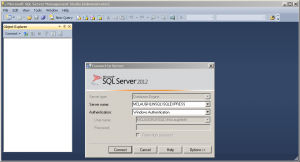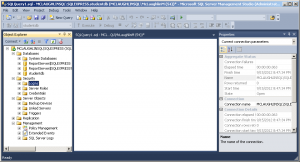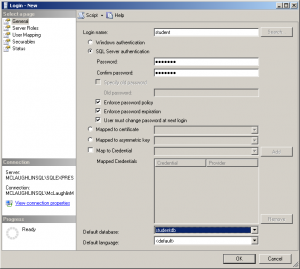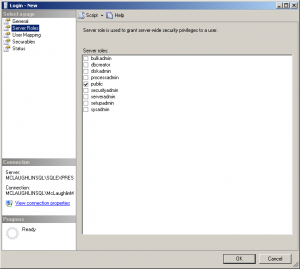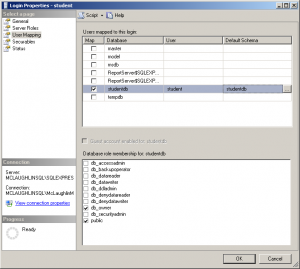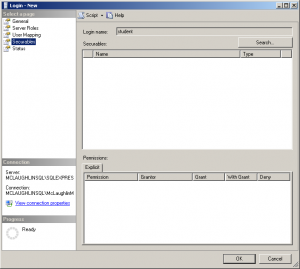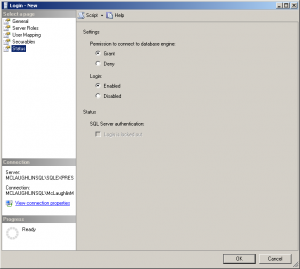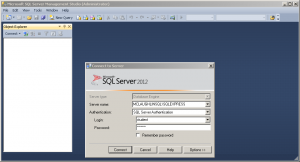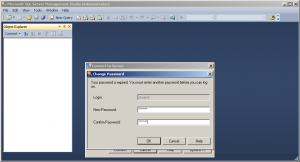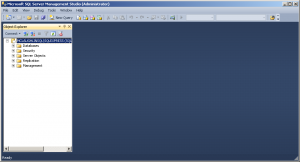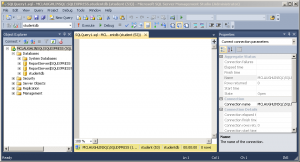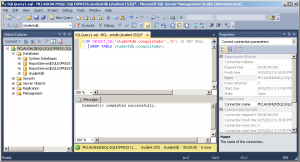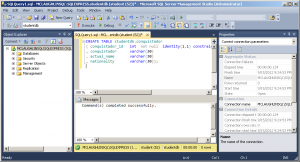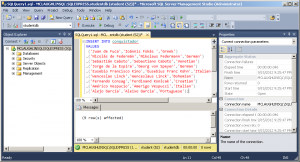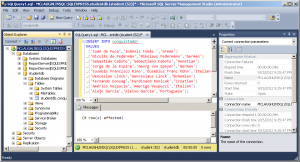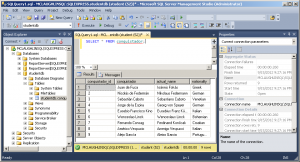Archive for the ‘SQL Server 2008’ Category
Variable Scope
SELECT-list, there are rules for how you can assign the SELECT-list values. The process is more or less an all or nothing approach when assigning values to a local variable.
The rule is quite simple for scalar variables because the SELECT-list may contain multiple values but assignments must be made one at a time. You can’t mix retrieving values with assignments. Lets say you try to write the following block of T-SQL code:
1 2 3 4 5 | SELECT 'Execution Scope' AS "Statement"; DECLARE @base NVARCHAR(MAX) = N''; WITH x AS (SELECT 'Chilly' AS cold, 'Burning up' AS hot) SELECT @base += cold, hot FROM x; SELECT @base AS "Result"; |
Msg 141, Level 15, State 1, Server DESKTOP-4U7EN27, Line 3 A SELECT statement that assigns a value to a variable must not be combined with data-retrieval operations. |
1 2 3 4 5 | SELECT 'Execution Scope' AS "Statement"; DECLARE @base NVARCHAR(MAX) = N''; WITH x AS (SELECT 'Chilly' AS cold, 'Burning up' AS hot) SELECT @base += cold FROM x; SELECT @base AS "Result"; |
SELECT-list, the assignment statement appends the value associated with the column name or alias, which acts like a key in a dictionary. While a dictionary is a collection of name and value pairs, you can use the name of any dictionary element as a key to return only one value from the dictionary. That is the value that the name identifies in the dictionary.
You can put a GO on line 6 in an interactive session or you can put the five lines into a T-SQL script file and call it from the sqlcmd utility. You can run the script file with the following syntax, assuming you have a student user with student as its password working against items in the studentdb schema:
sqlcmd -Ustudent -Pstudent -dstudentdb -y40 -itestScope.sql -otestScope.out |
GO command. T-SQL script files are bundles that execute in a single execution scope unless you embed the GO command.
Then, you can display the testScope.out file as follows from the command line (in a cmd session):
type testScope.out |
Statement --------------- Execution Scope (1 rows affected) Result ---------------------------------------- Chilly (1 rows affected) |
SQL Server XQuery
I promised my students an example of writing xquery statements in Microsoft SQL Server. This post builds on two earlier posts. The first qualifies how to build a marvel table with source data, and the second qualifies how you can create an XML Schema Collection and insert relational data into an XML structure.
You can query a sequence with xquery as follows:
DECLARE @x xml; SET @x = N''; SELECT @x.query('(1,2,(10,11,12,13,14,15)),-6'); |
It returns:
1 2 10 11 12 13 14 15 -6 |
You can query a sequence with an xquery FLOWR statement. FLOWR stands for: FOR, LET, ORDER BY, WHERE, and RETURN. A sample xquery with a FLOWER statement is:
DECLARE @x xml; SET @x = N''; SELECT @x.query('for $i in ((1,2,(10,11,12,13,14,15)),-6) order by $i return $i'); |
It returns:
-6 1 2 10 11 12 13 14 15 |
You can query the entire node tree with the following xquery statement because it looks for the occurrence of any node with the /* search string:
DECLARE @x xml; SET @x = N'<marvel> <avenger_name>Captain America</avenger_name> </marvel>'; SELECT @x.query('/*'); |
You can query the avenger_name elements from the marvel_xml table with the following syntax:
SELECT xml_table.query('/marvel/avenger_name') FROM marvel_xml; |
It returns the following set of avenger_name elements:
<avenger_name>Hulk</avenger_name> <avenger_name>Iron Man</avenger_name> <avenger_name>Black Widow</avenger_name> <avenger_name>Thor</avenger_name> <avenger_name>Captain America</avenger_name> <avenger_name>Hawkeye</avenger_name> <avenger_name>Winter Soldier</avenger_name> <avenger_name>Iron Patriot</avenger_name> |
You can query the fourth avenger_name element from the marvel_xml table with the following xquery statement:
SELECT xml_table.query('/marvel[4]/avenger_name') FROM marvel_xml; |
It returns the following avenger_name element:
<avenger_name>Thor</avenger_name> |
You can use the value() function to verify an avenger_name element exists:
SELECT CASE WHEN xml_table.value('(/marvel[4]/avenger_name)','nvarchar') = 'T' THEN 'Exists' END AS "Verified" FROM marvel_xml WHERE id = 3; |
The query returns the Exists string when it finds a valid avenger_name element. You have a number of other tools to query results sets from the XML node tree.
I hope this helps my students and anybody interested in writing xquery-enable queries.
Insert into XML Column
Working through Chapter 7 of the Querying Microsoft SQL Server 2012 book for Microsoft’s Exam 70-461, I found the XML examples incomplete for my students. I decided to put together a post on how to create:
- An XML Schema Collection type.
- A table that uses an XML Schema Collection as a column’s data type.
- An example on how you can transfer the contents of a table into the XML Schema Collection.
This post assumes you understand the basics about XML structures. If you’re unfamiliar with XML, please note that everything within it is case sensitive unlike SQL. You raise exceptions when the case of your XML fails to match the case of your XML Schema Collection definitions. I raised the following exception by using a Marvel element tag in title case when the XML Schema Collection uses a lowercase marvel element tag:
Msg 6913, Level 16, State 1, Line 2 XML Validation: Declaration not found for element 'Marvel'. Location: /*:Marvel[1] |
The basic marvel table is defined in this earlier blog post. To ensure you don’t run into conflicts with previously existing objects, you can delete the marvel table with the following syntax:
1 2 | IF OBJECT_ID('studentdb.marvel_xml','U') IS NOT NULL DROP TABLE marvel_xml; |
There is no predefined function that lets you conditionally drop the XML Schema Collection from the data base. The alternative is to query the Microsoft SQL Server data catalog for the existence of a row before dropping the XML Schema Collection, like this:
1 2 3 4 | IF EXISTS (SELECT * FROM sys.xml_schema_collections WHERE name = 'MarvelXMLTable') DROP XML SCHEMA COLLECTION MarvelXMLTable; ELSE SELECT 'Not found.'; |
You can now create the MarvelXMLTable XML Schema Collection with the following syntax:
1 2 3 4 5 6 7 8 9 10 11 12 13 14 15 16 17 | CREATE XML SCHEMA COLLECTION MarvelXMLTable AS N'<?xml version="1.0" encoding="UTF-16"?> <xsd:schema xmlns:xsd="http://www.w3.org/2001/XMLSchema" xmlns:sqltypes="http://schemas.microsoft.com/sqlserver/2004/sqltypes"> <xsd:import namespace="http://schemas.microsoft.com/sqlserver/2004/sqltypes" schemaLocation="http://schemas.microsoft.com/sqlserver/2004/sqltypes/sqltypes.xsd" /> <xsd:element name="Marvel"> <xsd:complexType> <xsd:sequence> <xsd:element name="marvel_id" type="sqltypes:int" /> <xsd:element name="avenger_name" type="sqltypes:nvarchar" /> <xsd:element name="first_name" type="sqltypes:nvarchar" /> <xsd:element name="last_name" type="sqltypes:nvarchar" /> </xsd:sequence> </xsd:complexType> </xsd:element> </xsd:schema>'; |
After creating the XML Schema Collection, you can confirm whether it works correctly with the following statements. It will fail when you use semicolons on the DECLARE or SET lines, so avoid them as shown below:
1 2 3 4 5 6 7 8 | DECLARE @marvel AS XML(MarvelXMLTable) SET @marvel = '<marvel> <marvel_id>1</marvel_id> <avenger_name>Falcon</avenger_name> <first_name>Sam</first_name> <last_name>Wilson</last_name> </marvel>' SELECT @marvel; |
After creating and verifying the integrity of the XML Schema Collection, you can create a marvel_xml table. The xml_table column of the marvel_xml table uses a strongly-typed XML type, as shown:
1 2 3 | CREATE TABLE marvel_xml ( id INT IDENTITY(1,1) CONSTRAINT marvel_xml_pk PRIMARY KEY , xml_table XML(MarvelXMLTable)); |
You can write an INSERT statement with single element like this:
1 2 3 4 5 6 7 8 9 | INSERT INTO marvel_xml ( xml_table ) VALUES ('<Marvel> <marvel_id>9</marvel_id> <avenger_name>Falcon</avenger_name> <first_name>Sam</first_name> <last_name>Wilson</last_name> </Marvel>'); |
You can insert two elements with an INSERT statement like this:
1 2 3 4 5 6 7 8 9 10 11 12 13 14 15 | INSERT INTO marvel_xml ( xml_table ) VALUES ('<Marvel> <marvel_id>9</marvel_id> <avenger_name>Falcon</avenger_name> <first_name>Sam</first_name> <last_name>Wilson</last_name> </Marvel> <Marvel> <marvel_id>10</marvel_id> <avenger_name>Scarlet Witch</avenger_name> <first_name>Wanda</first_name> <last_name>Witch</last_name> </Marvel>'); |
There’s a lot of typing to insert XML literal values. It a lot easier to transfer relational data from a table to an XML type. Unfortunately, Microsoft didn’t make it very easy. The FOR XML AUTO doesn’t work for two reasons. First, the FOR XML AUTO clause doesn’t render the correct XML structure. Second, the INSERT statement disallows nested SELECT queries that include the FOR XML AUTO clause.
Here’s the way you insert relational data into an XML type column:
1 2 3 4 5 6 7 8 9 10 11 12 13 | DECLARE @xml_elements NVARCHAR(MAX); SET @xml_elements = N''; WITH x AS (SELECT CONCAT(N'<marvel>' ,N'<marvel_id>',marvel_id,N'</marvel_id>' ,N'<avenger_name>',avenger_name,N'</avenger_name>' ,N'<first_name>',first_name,N'</first_name>' ,N'<last_name>',last_name,N'</last_name>' ,N'</marvel>') AS element FROM marvel) SELECT @xml_elements += element FROM x; INSERT INTO marvel_xml (xml_table) VALUES (@xml_elements); |
Line 1 declares an xml_element session variable. Line 2 initializes the xml_element session variable as an empty string. The WITH clause on lines 3 through 10 creates a Common Table Expression (CTE) with the valid XML structure for all rows in the marvel table. The nested SELECT statement on line 11 returns data from the CTE and adds returned row to the session-level string variable. Finally, the INSERT statement on lines 12 and 13 inserts the XML table into the xml_table column.
You can then query the table with the following statement:
SELECT xml_table FROM marvel_xml; |
Click on the return type in the SQL Server Management Studio (SSMS), and the XML structure will expand to show this:
<marvel> <marvel_id>1</marvel_id> <avenger_name>Hulk</avenger_name> <first_name>Bruce</first_name> <last_name>Banner</last_name> </marvel> <marvel> <marvel_id>2</marvel_id> <avenger_name>Iron Man</avenger_name> <first_name>Tony</first_name> <last_name>Stark</last_name> </marvel> <marvel> <marvel_id>3</marvel_id> <avenger_name>Black Widow</avenger_name> <first_name>Natasha</first_name> <last_name>Romanoff</last_name> </marvel> <marvel> <marvel_id>4</marvel_id> <avenger_name>Thor</avenger_name> <first_name>Thor</first_name> <last_name>Odinsson</last_name> </marvel> <marvel> <marvel_id>5</marvel_id> <avenger_name>Captain America</avenger_name> <first_name>Steve</first_name> <last_name>Rogers</last_name> </marvel> <marvel> <marvel_id>6</marvel_id> <avenger_name>Hawkeye</avenger_name> <first_name>Clint</first_name> <last_name>Barton</last_name> </marvel> <marvel> <marvel_id>7</marvel_id> <avenger_name>Winter Soldier</avenger_name> <first_name>Bucky</first_name> <last_name>Barnes</last_name> </marvel> <marvel> <marvel_id>8</marvel_id> <avenger_name>Iron Patriot</avenger_name> <first_name>James</first_name> <last_name>Rhodey</last_name> </marvel> |
As always, I hope this post benefits those who read it.
A T-SQL Table Function
I had an interesting conversation about table functions in Oracle’s PL/SQL; and the fact that they’re not available in MySQL. When I explained they’re available in Microsoft T-SQL User-Defined Functions (UDFs), my students wanted a small example. One of them said they’d tried to do it but couldn’t get it to work because they found the Microsoft web pages difficult to read and use. Specifically, they didn’t like the sparseness of this one on how to create a function.
Here’s a quick definition of a UDF table function that runs in the studentdb schema (created in this post for migrating SQL Server into a MySQL database). The following getConquistador function takes a single string, which acts to filter the result set from a query positioned as the return value of the function. You should note that this is an implementation of Microsoft’s Common Language Infrastructure (CLI).
CREATE FUNCTION studentdb.getConquistador (@nationality AS VARCHAR(30)) RETURNS TABLE RETURN SELECT * FROM studentdb.conquistador WHERE nationality = @nationality; |
Unlike Oracle SQL, where you need to use the TABLE function to read the content of a table result from a function, you don’t need anything other than the function call in the FROM clause of a T-SQL query. Here’s an example of calling the table function:
SELECT * FROM studentdb.getConquistador('German'); |
The complete result from the query would produce these results when run from the sqlcmd command-line interface:
conquistador_id conquistador actual_name nationality
--------------- --------------------- -------------------- ------------
11 Nicolas de Federman Nikolaus Federmann German
13 Jorge de la Espira George von Speyer German
(2 rows affected) |
However, you also have the ability to query only rows of interest without any specialized syntax, like this:
1> USE studentdb; 2> SELECT conquistador AS "Conquistador" 3> , actual_name AS "Name" 4> FROM studentdb.getConquistador('German'); 5> GO |
This produces the following two-column result set:
Conquistador Name --------------------- -------------------- Nicolas de Federman Nikolaus Federmann Jorge de la Espira George von Speyer (2 rows affected) |
Hope this helps those interested in T-SQL UDFs.
Setup SQL Server Schema
After you’ve installed Microsoft SQL Server 2012 and created a database schema, you still need to setup or configure the database schema. This is the recommended Microsoft SQL Server Best Practice.That means you must grant permissions to a user to work in the database schema, otherwise you get the following type of error message.
Msg 2760, Level 16, State 1, Line 1 The specified schema name "studentdb" either does not exist or you do not have permission to use it. |
You receive the foregoing error message when trying to create a table in a database schema that hasn’t been assigned a user or role. This typically occurs after you create a new database schema, which has a <default> owner.
For those new to the idea of schemas (or scheme), they were introduced by Microsoft in SQL Server 2005. Here are some rules of thumb on schemas:
- Database schema names are distinct from user names.
- Multiple users may share a schema, which means it can hold objects owned by multiple users.
- Permissions to act inside the schema may be granted to individual users, and you have a varied set of privileges that you can assign to users.
- Ownership of objects in a schema can be transferred using the
ALTER SCHEMAcommand. - Ownership of a schema can be changed by using the
ALTER AUTHORIZATIONcommand. - Database users can be dropped without changing objects in schemas, which is a big difference between Oracle and SQL Server.
The following example occurs when you try to create a table in a studentdb database schema. It doesn’t expose you to the SQL syntax but demonstrates how to manage the changes within the SQL Server Management Studio (SSMS).
By the way, you start the new schema creation process by right clicking on the Databases folder in the SQL Server Management Studio. Then, you give the new database schema a name in the New Database dialog; and click the OK button to complete the process.
The balance of the instructions show you how to create a user account that will map to your new database schema. It assumes you’ve installed it on your local machine and have privileges through local Windows Authentication to the System Administrator (sa) account. You create a student user account, assign the studentdb database schema, log off as the System Administrator, log in as the new user, conditionally drop a table from the studentdb schema, create a table in the studentdb schema, and query the results. It’s also possible to create the user first, database second, and assign the database as the default database for the user account.
- The first screen asks you to authenticate as the System Administrator using Windows Authentication. Click the Connect button to connect to the SQL Server Management System (SMSS).
- Click the Security folder and expand the subordinate list of folders. Right click on the Logins folder and click on the New Login option in the context menu. It launches a new dialog where you enter a user account.
- On the General page of the Login – New dialog, enter a Login name and click the SQL Server authentication radio button. Clicking the radio button enables the Password and Confirm password fields where you enter the same password twice. Click the Default database drop down and choose the studentdb created earlier. Click the Server Roles page to continue.
- On the Server Roles page, ensure that only the public server role is checked. Click on the User Mapping page to continue.
- On the User Mapping page, click the Map check box for the
studentdbdatabase, enterstudentin the User field, and enterstudentdbin the Default Schema field. Click the db_owner and public database role membership forstudentdb. Click on the Securables page to continue.
- There are no required changes on the Securables page. Check that screen matches the illustration at the left, and click on the Status page to continue.
- There are no required changes on the Status page. Check that screen matches the illustration at the left, and click on the OK button to complete creating the user. Then, exit the SQL Server Management Studio as the System Administrator.
- Launch the SQL Server Management Studio, choose SQL Server Authentication as the authentication method, and enter the
studentLogin (user name) and Password before clicking the Connect button to continue.
- The first time a user logs in, they must re-enter a valid password. After entering the password twice, click the OK button to continue.
- The initial display shows only the Object Explorer. Click the New Query option in the menu toolbar.
- Click on the Databases folder to expand the list and you will see the
studentdbdatabase schema displayed, as shown in the illustration on the left.
- Enter a conditional drop of a
conquistadortable from thestudentdbdatabase schema. Click the Execute button from the toolbar menu to run the statement.
IF OBJECT_ID('studentdb.conquistador','U') IS NOT NULL DROP TABLE studentdb.conquistador; |
- Enter a
CREATEstatement for aconquistadortable in thestudentdbdatabase schema. Click the Execute button from the toolbar menu to run the statement.
CREATE TABLE studentdb.conquistador ( conquistador_id INT NOT NULL IDENTITY(1,1) CONSTRAINT pk_conquistador PRIMARY KEY , conquistador VARCHAR(30) , actual_name VARCHAR(30) , nationality VARCHAR(30)); |
- Enter an
INSERTstatement to theconquistadortable in thestudentdbdatabase schema. Click the Execute button from the toolbar menu to run the statement and see that it inserted 9 rows.
INSERT INTO conquistador VALUES ('Juan de Fuca','Ioánnis Fokás','Greek') ,('Nicolás de Federmán','Nikolaus Federmann','German') ,('Sebastián Caboto','Sebastiano Caboto','Venetian') ,('Jorge de la Espira','Georg von Speyer','German') ,('Eusebio Francisco Kino','Eusebius Franz Kühn','Italian') ,('Wenceslao Linck','Wenceslaus Linck','Bohemian') ,('Fernando Consag','Ferdinand Konšcak','Croatian') ,('Américo Vespucio','Amerigo Vespucci','Italian') ,('Alejo García','Aleixo Garcia','Portuguese'); |
- Click the
studentdbfolder to expand content, and you should see theconquistadortable.
SELECT * FROM conquistador; |
- Click in the SQL Query frame and enter a query against the
conquistadortable. Click the Execute button to run the query and you should see the following output from theconquistadortable.
As always, I hope this helps those trying to sort out how to solve a similar problem.
Trying to Migrate Data
Getting the MySQL Workbench’s Database Migration has been interesting, and at present incomplete. While I can now successfully connect to the SQL Server 2012 source database and capture a schemata list, migrating the data from SQL Server doesn’t work. Actually, the connection doesn’t work without modifying a Python library in the current MySQL Workbench release.
I blogged about the SQL Server 2012 installation and Windows SQL Server DSN setup last night because the development manager requested them to create a repeatable test case to help resolve Bug 66516. The existing blog post on the MySQL Workbench blog provides step-by-step instructions, so I passed on providing them. This post documents how far I’ve been able to get with the database migration and where I’m stuck.
MySQL Workbench 5.2.42, which is the current release at time of writing, doesn’t retrieve a schemata list from SQL Server 2008 or 2012 unless you edit one of the Python libraries. The instructions for the change are in Bug 66030.
You need to edit the db_mssql_grt.py source file and include the fix from the bug. While the bug lists where to find the file on Mac OS X, you find the db_mssql_grt.py source and compiled files are in the following Windows directory (on a 64-bit OS). Then, you delete the db_mssql_grt.pyc file, which is recompiled the next time you launch MySQL Workbench and there’s a call to a function in the module (or library).
C:\Program Files (x86)\MySQL\MySQL Workbench 5.2 CE\modules |
You need to edit line 173, and add the CAST function call before you attempt the migration.
170 171 172 173 174 175 176 177 178 | def getServerVersion(connection): """Returns a GrtVersion instance containing information about the server version.""" version = grt.classes.GrtVersion() ver_string = execute_query(connection, "SELECT CAST(SERVERPROPERTY('ProductVersion') AS VARCHAR)").fetchone()[0] ver_parts = [ int(part) for part in ver_string.split('.') ] + 4*[ 0 ] version.majorNumber, version.minorNumber, version.releaseNumber, version.buildNumber = ver_parts[0:4] return version @ModuleInfo.export(grt.LIST, grt.classes.db_mgmt_Connection) |
After editing the file and saving it, you need to delete the compiled version and start MySQL Workbench to generate the db_mssql_grt.pyc. If MySQL Workbench is running you need to shut it down after deleting the compiled Python file and restart it to generate a new compiled file.
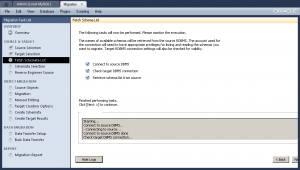 Having fixed the error, you should see verification of your connection to the Microsoft SQL Server. If it fails at this point, you have made an error installing or configuring the Microsoft SQL Server or Windows DSN, or you haven’t made the change to the
Having fixed the error, you should see verification of your connection to the Microsoft SQL Server. If it fails at this point, you have made an error installing or configuring the Microsoft SQL Server or Windows DSN, or you haven’t made the change to the db_mssql_grt.py file.
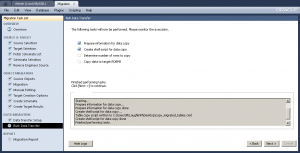 All the other steps work except for copying the data from the Microsoft SQL Server to the MySQL Server. The failure occurs in Bulk Data Transfer segment of the Database Migration wizard. The first error occurs on the Determine number of rows to copy step. The error log didn’t help very much, so I generated the manual script file.
All the other steps work except for copying the data from the Microsoft SQL Server to the MySQL Server. The failure occurs in Bulk Data Transfer segment of the Database Migration wizard. The first error occurs on the Determine number of rows to copy step. The error log didn’t help very much, so I generated the manual script file.
Testing the generated script manually it fails to connect to the SQL Server instance. It appears the command syntax in the generated script is incorrect or one or more of the choices made during the installation of SQL Server or definition of the Windows SQL Server DSN is incorrect.
Here’s the generated script file:
REM Workbench Table Data copy script REM REM Execute this to copy table data from a source RDBMS to MySQL. REM Edit the options below to customize it. You will need to provide passwords, at least. REM REM Source DB: Mssql@SQL Server ODBC (Microsoft SQL Server) REM Target DB: Mysql@mclaughlinsql:3306 REM Source and target DB passwords REM set arg_source_password= REM set arg_target_password= REM Uncomment the following options according to your needs REM Whether target tables should be truncated before copy REM set arg_truncate_target=--truncate-target REM Enable debugging output REM set arg_debug_output=--log-level=debug3 wbcopytables.exe '--odbc-source=DSN=SQL Server ODBC;DATABASE=studentdb;UID=sa' --target=student@mclaughlinsql:3306 --source-password=%arg_source_password% --target-password=%arg_target_password% %arg_truncate_target% %arg_debug_output% --table '[dbo].[ORGANIZATION]' '`studentdb`' '`ORGANIZATION`' |
You need to add the following directory to your %PATH% environment variable to test a call to wbcopytables executable:
SET PATH=%PATH%;C:\Program Files (x86)\MySQL\MySQL Workbench 5.2 CE |
The following call to the wbcopytables executable requires you unremark the source and target password statements or set them externally from the script. This call should connect and migrate data from the Microsoft SQL Server database to the MySQL Workbench.
wbcopytables.exe --odbc-source='[DSN=SQL Server ODBC;DATABASE=studentdb;UID=sa]' --target=student@mclaughlinsql:3306 --source-password=cangetin --target-password=student --table '[dbo].[ORGANIZATION]' '`studentdb`' '`ORGANIZATION`' |
However, running it in my environment generates the following error:
wbcopytables.exe: Invalid option '--odbc-source=DRIVER={.\SQLEXPRESS};DSN=SQL |
This was resolved by development in MySQL Workbench 5.2.43; and you can reference Bug 66516 for more information. Although, you need to watch out for character set mismatches, as qualified in this later post.
Missing Features in R2
![]() As I’ve mentioned before, I try to support Oracle, MySQL, and SQL Server in my database classes. When I downloaded SQL Server 2008 R2 Express Edition, I just downloaded the Database with Management Tools. That’s the one on the first page and shown on the left.
As I’ve mentioned before, I try to support Oracle, MySQL, and SQL Server in my database classes. When I downloaded SQL Server 2008 R2 Express Edition, I just downloaded the Database with Management Tools. That’s the one on the first page and shown on the left.
It appears what I really wanted was the Database with Advanced Services because I found basic features weren’t available in the Database with Management Tools version. So, you should click the Other Installation Options link. On that page you can choose between the various options.
For example, you can’t use an IF statement or local variable assignment. Also, the available data types are a subset of the mainline product. You can’t use a VARCHAR but must use the NVARCHAR. Many features of the Microsoft SQL Server Management Studio are removed too. A brief forum discussion shows that these types of problem exist in other versions too.
I thought a couple quick examples of raised exceptions would be helpful. They’re listed below.
Missing IF Syntax:
IF EXISTS (SELECT * FROM INFORMATION_SCHEMA.TABLES WHERE TABLE_NAME = 'CORE_SYSTEM_USER') DROP TABLE CORE_SYSTEM_USER GO |
Generated error message:
Major Error 0x80040E14, Minor Error 25501 > IF EXISTS (SELECT * FROM INFORMATION_SCHEMA.TABLES WHERE TABLE_NAME = 'CORE_SYSTEM_USER') DROP TABLE CORE_SYSTEM_USER There was an error parsing the query. [ Token line NUMBER = 1,Token line offset = 1,Token IN error = IF ] |
Local variable assignment Syntax:
DECLARE @TABLE_NAME nvarchar(30) @TABLE_NAME = SELECT TABLE_NAME FROM INFORMATION_SCHEMA.TABLES WHERE TABLE_NAME = 'CORE_SYSTEM_USER' GO |
Generated error message:
Major Error 0x80040E14, Minor Error 25501 > DECLARE @TABLE_NAME nvarchar(30) @TABLE_NAME = SELECT TABLE_NAME FROM INFORMATION_SCHEMA.TABLES WHERE TABLE_NAME = 'CORE_SYSTEM_USER' There was an error parsing the query. [ Token line NUMBER = 1,Token line offset = 1,Token IN error = DECLARE ] |
After I clear out the install and retry it with the other, I’ll update this as to whether or not these are available in the Database with Advanced Services SQL Server 2008 R2 Express Edition.
SQL Aggregation Tutorial
I’ve been working on a Basic Aggregation tutorial for my students. I think this might be close to what may benefit them. However, I thought it would be great to put it out there and solicit ideas. If you have some on improving this post, please let me know.
My first take at the post …
This is a lesson on basic aggregation in SQL. Aggregation in SQL means counting, adding, and grouping by results of counts or sums. Aggregation is a critical part of using the SQL language. At a basic level, aggregation includes the COUNT, SUM, AVERAGE, MAX, and MIN aggregation functions; and the ORDER BY, GROUP BY, and HAVING clauses.
You’ll find the setup scripts for these examples at the bottom of this blog page. The best way to use this page is to copy the setup code, run it in your database, and then test the examples as you work though them.
Data set ↓
This section discusses the data set. You unfold it by clicking on the bold text above.
The illustration of aggregation is a challenge because a trivial set of numbers doesn’t present much challenge or sometimes relevance but it shows the basic concept. A more applied sample set makes mental calculation and comprehension of functions more difficult. As a result of that trade off, this uses two copies of the ordinal numbers (ordinal numbers are the single digit integers from zero to nine).
After you run the setup script, you can display the data set with the following query.
-- Oracle only SQL*Plus formatting command to smooth output display. SET PAGESIZE 99 -- Query ordered by the sets and then the integers in ascending order. SELECT * FROM ordinal ORDER BY 2, 4; |
You could have sorted them more easily by using the ORDINAL_ID surrogate key column but it wouldn’t demonstrate the ORDER BY clause. In some database, like Oracle and MySQL, the ORDER BY lets you use column names, column aliases, or the position order of the column in the SELECT clause. Unfortunately, this isn’t true across all databases.
The ORDER BY clause does let you see that you can set nested ordering, like the numbers inside the data sets that are qualified by the LIST_SET column. This is demonstrated in the output below.
ORDINAL_ID LIST_SET LIST_NAME LIST_VALUE
---------- -------------------- ---------- ----------
1 Value Set A Zero 0
2 Value Set A One 1
3 Value Set A Two 2
4 Value Set A Three 3
5 Value Set A Four 4
6 Value Set A Five 5
7 Value Set A Six 6
8 Value Set A Seven 7
9 Value Set A Eight 8
10 Value Set A Nine 9
11 Value Set A
12 Value Set B Zero 0
13 Value Set B One 1
14 Value Set B Two 2
15 Value Set B Three 3
16 Value Set B Four 4
17 Value Set B Five 5
18 Value Set B Six 6
19 Value Set B Seven 7
20 Value Set B Eight 8
21 Value Set B Nine 9
22 Value Set B |
Single row aggregation function use ↓
This section discusses and demonstrates the five aggregation functions in the post. They return a single row of data. Like the other sections, you unfold this by clicking on the bold text above.
COUNT function
The COUNT function has two behaviors that may apply. One is when you count rows and the other is when you count values. Both return only a single row.
Counting by Reference: The following example demonstrates counting rows. In this scenario, the COUNT function takes a single call parameter, which is an asterisk (*). The asterisk actually counts the references to the rows in the table, and in Oracle is equivalent to COUNT(ROWID). The pseudo column ROWID points to the physical block address where the row is stored in the database. As such, the asterisk acts very much like a pointer in the C or C++ language (that is if you substitute a block address for a memory address).
SELECT COUNT(*) FROM ordinal; |
It returns
COUNT(*) ---------- 22 |
When you count rows, you count them whether they contain values or not. It is possible that you could insert a meaningless row with null values for all columns in a table that’s unconstrained. Moreover, the COUNT function counts all rows no matter whether contain any values.
Counting by Value: The following examples demonstrate approaches to counting values. It’s important to note that when you count values, you ignore null values. You can also count distinct things or all things when you count by value.
The LIST_SET column doesn’t contain any null values (as you can see by inspecting the data set early in this blog page). The following counts the number of values in the LIST_SET column. You could also substitute COUNT(ALL list_set) and it would return the same thing because ALL is the default and always provided unless you override it with a DISTINCT keyword.
SELECT COUNT(list_set) FROM ordinal; |
It returns:
COUNT(*) ---------- 22 |
Since the LIST_SET column only contains one of two values, you can count that to make sure. You do it with the following syntax:
SELECT COUNT(DISTINCT list_set) FROM ordinal; |
It returns:
COUNT(*) ---------- 2 |
The LIST_NAME and LIST_VALUE both contain two null values. Let’s see what they return when we count all or distinct values. This example simplifies it a step more by performing both counts side-by-side. This is possible because both columns return a single row.
SELECT COUNT(ALL list_name) AS name_number , COUNT(DISTINCT list_value) AS value_number FROM ordinal; |
It returns the twenty total string values found in the first column and the ten unique numeric values found in the second column. The COUNT function with the DISTINCT filter acts like a COUNT function with a GROUP BY clause on the LIST_VALUE column, as you’ll see later in the discussion.
NAME_NUMBER VALUE_NUMBER ----------- ------------ 20 10 |
SUM, AVERAGE, MAX, and MIN functions
Math Operations by Value: These math aggregations are done with the SUM, AVERAGE, MAX, and MIN aggregation functions. They’re restricted to columns that contain numeric values. Each of them support the default ALL or DISTINCT keywords and they behave much as the COUNT function discussed earlier.
There is a significant difference between their functionality. You can count unique strings but you can’t sum a column of numbers based on that other column without a GROUP BY clause. You see examples of the GROUP BY in the next part of this post.
Since these behave more or less the same, their examples are grouped together in sections by summing and averaging together, and taking the maximum and minimum values together. For reference, the ordinal numbers sum to 45, two sets of them are naturally 90; and the average of evenly dispersed numbers is half, or 45, and their unique values 4.5.
SELECT SUM(ALL list_value) AS sum_all , SUM(DISTINCT list_value) AS sum_distinct , AVG(ALL list_value) AS avg_all , AVG(DISTINCT list_value) AS avg_distinct FROM ordinal; |
It returns:
SUM_ALL SUM_DISTINCT AVG_ALL AVG_DISTINCT ---------- ------------ ---------- ------------ 90 45 4.5 4.5 |
The next section makes the same comparison with the MAX, and MIN functions. The maximum or minimums are the same because they the uniqueness doesn’t change the minimum or maximum of the sets.
SELECT MIN(ALL list_value) AS min_all , MIN(DISTINCT list_value) AS min_distinct , MAX(ALL list_value) AS max_all , MAX(DISTINCT list_value) AS max_distinct FROM ordinal; |
It returns:
MIN_ALL MIN_DISTINCT MAX_ALL MAX_DISTINCT ---------- ------------ ---------- ------------ 0 0 9 9 |
Multiple row aggregation function use ↓
This section discusses and demonstrates the five aggregation functions where they return more than a single row of data, which involves grouping by non-aggregated columns. This section covers the GROUP BY and HAVING clauses. Like the other sections, you unfold this by clicking on the bold text above.
COUNT function
Counting by Groups: The following example demonstrates how we can count rows or values by groups. The example counts rows by reference and value, but it does so by grouping the return values on the unique string values in the LIST_SET column.
1 2 3 4 5 | SELECT list_set AS grouping_by_column , COUNT(*) , COUNT(list_value) FROM ordinal GROUP BY list_set; |
It returns the following values:
GROUPING_BY_COLUMN COUNT(*) COUNT(LIST_VALUE) -------------------- ---------- ----------------- VALUE SET A 11 10 VALUE SET B 11 10 |
The results show that there are eleven rows for each set, and that ten of the rows contain values while one holds a null value.
You can also group on columns that contain null values or sets of columns. The following example groups by two columns, where one contains a null value.
1 2 3 4 5 6 7 8 | SELECT list_set AS grouping_by_not_null , list_name AS group_by_null_too , COUNT(*) , COUNT(list_value) FROM ordinal WHERE list_set = 'Value Set A' GROUP BY list_set , list_name; |
It returns the following values:
GROUPING_BY_NOT_NULL GROUP_BY_NULL_TOO COUNT(*) COUNT(LIST_VALUE) -------------------- ----------------- ---------- ----------------- VALUE SET A Zero 1 1 VALUE SET A Five 1 1 VALUE SET A Three 1 1 VALUE SET A Four 1 1 VALUE SET A One 1 1 VALUE SET A Two 1 1 VALUE SET A Eight 1 1 VALUE SET A Nine 1 1 VALUE SET A Seven 1 1 VALUE SET A Six 1 1 VALUE SET A 1 0 |
The last row returned is the one where the grouping by column value and counted column value are null. You should note that the GROUP BY applies to a string column and the return set includes a row grouped by its null value. The count of null column values is always zero.
Another thing that you may have not noticed is that the rows are no longer in ascending numeric order by LIST_NAME or LIST_VALUE columns. There’s a multiple edge sword when you examine why this occurs. Basically with regard to the LIST_NAME column, Oracle and many other databases use advanced sorting algorithms which may leave non-ordered sets as outcomes. The LIST_VALUE column is not in the GROUP BY clause and therefore can’t be used as an ORDER BY key.
When you attempt to use a column outside of the GROUP BY clause to order the return set, like this:
1 2 3 4 5 6 7 8 9 | SELECT list_set AS grouping_by_not_null , list_name AS group_by_null_too , COUNT(*) , COUNT(list_value) FROM ordinal WHERE list_set = 'Value Set A' GROUP BY list_set , list_name ORDER BY list_value; |
You would see the following error in an Oracle Database 10g instance:
ORDER BY list_value * ERROR at line 9: ORA-00979: NOT a GROUP BY expression |
You can filter this particular set because the conditions are limited, but this wouldn’t be a good idea in many other solution sets. However, it certainly highlights some of the potential for extraordinary sorting of result sets.
1 2 3 4 5 6 7 8 9 10 11 12 13 14 15 16 17 18 19 20 | SELECT list_set AS grouping_by_not_null , list_name AS group_by_null_too , COUNT(*) , COUNT(list_value) FROM ordinal WHERE list_set = 'Value Set A' GROUP BY list_set , list_name ORDER BY CASE WHEN list_name = 'Zero' THEN 0 WHEN list_name = 'One' THEN 1 WHEN list_name = 'Two' THEN 2 WHEN list_name = 'Three' THEN 3 WHEN list_name = 'Four' THEN 4 WHEN list_name = 'Five' THEN 5 WHEN list_name = 'Six' THEN 6 WHEN list_name = 'Seven' THEN 7 WHEN list_name = 'Eight' THEN 8 WHEN list_name = 'Nine' THEN 9 END; |
It returns the following values:
GROUPING_BY_NOT_NULL GROUP_BY_NULL_TOO COUNT(*) COUNT(LIST_VALUE) -------------------- ----------------- ---------- ----------------- VALUE SET A Zero 1 1 VALUE SET A One 1 1 VALUE SET A Two 1 1 VALUE SET A Three 1 1 VALUE SET A Four 1 1 VALUE SET A Five 1 1 VALUE SET A Six 1 1 VALUE SET A Seven 1 1 VALUE SET A Eight 1 1 VALUE SET A Nine 1 1 VALUE SET A 1 0 |
A better way to sort this type of data would involve putting it into an inline view and then joining it against the base data set. This allows you to use a non-grouping column as the sort key in an ORDER BY clause. Here’s an example of that approach but note it does take system overhead and should only be done when SQL must perform the sort operation.
1 2 3 4 5 6 7 8 9 10 11 12 13 14 15 | SELECT ilv.grouping_by_not_null , ilv.group_by_null_too , ilv.row_count , ilv.column_count FROM (SELECT list_set AS grouping_by_not_null , list_name AS group_by_null_too , COUNT(*) AS ROW_COUNT , COUNT(list_value) AS column_count FROM ordinal WHERE list_set = 'Value Set A' GROUP BY list_set , list_name) ilv LEFT JOIN ordinal o ON ilv.grouping_by_not_null = o.list_set AND ilv.group_by_null_too = o.list_name ORDER BY o.list_value; |
That returns a perfectly ordered set because the LEFT JOIN lets us capture the null value in the inline view without matching the two columns in the join condition. It returns the following set:
GROUPING_BY_NOT_NULL GROUP_BY_NULL_TOO ROW_COUNT COLUMN_COUNT -------------------- ----------------- ---------- ------------ Value Set A Zero 1 1 Value Set A One 1 1 Value Set A Two 1 1 Value Set A Three 1 1 Value Set A Four 1 1 Value Set A Five 1 1 Value Set A Six 1 1 Value Set A Seven 1 1 Value Set A Eight 1 1 Value Set A Nine 1 1 Value Set A 1 0 |
SUM, AVERAGE, MAX, and MIN functions
Math Operations by Groups: These math aggregations are done with the SUM, AVERAGE, MAX, and MIN aggregation functions. Like the previous single row return examples, they’re restricted to columns that contain numeric values. While they also support the default ALL or DISTINCT keywords, it didn’t seem necessary to demonstrate more of those behaviors here.
The following sums, averages, and gets both the minimum and maximum value by unique LIST_SET column values:
SELECT list_set AS grouping_by_not_null , SUM(list_value) AS ordinal_sum , AVG(list_value) AS ordinal_avg , MIN(list_value) AS ordinal_min , MAX(list_value) AS ordinal_max FROM ordinal GROUP BY list_set; |
It returns the following two rows:
GROUPING_BY_NOT_NULL ORDINAL_SUM ORDINAL_AVG ORDINAL_MIN ORDINAL_MAX -------------------- ----------- ----------- ----------- ----------- VALUE SET A 45 4.5 0 9 VALUE SET B 45 4.5 0 9 |
Expanding the GROUP BY criteria to include the LIST_NAME column, you see what happens when the SUM and AVG functions work with only null values. They always return null when adding only column values with a null value. This is handy as you’ll see in the selective aggregation discussion in a subsequent tutorial.
As done in the prior example, this filters out the second value set, to focus on what’s happening with the rows grouped on two columns.
1 2 3 4 5 6 7 8 9 10 | SELECT list_set AS grouping_by_not_null , list_name AS group_by_null_too , SUM(list_value) AS ordinal_sum , AVG(list_value) AS ordinal_avg , MIN(list_value) AS ordinal_min , MAX(list_value) AS ordinal_max FROM ordinal WHERE NOT list_set = 'Value Set B' GROUP BY list_set , list_name; |
It returns the following set of records, which are clearly out of order based on the algorithms that optimize aggregation. It’s not hard to read because there aren’t too many rows returned.
GROUPING_BY_NOT_NULL GROUP_BY_NULL_TOO ORDINAL_SUM ORDINAL_AVG ORDINAL_MIN ORDINAL_MAX -------------------- ----------------- ----------- ----------- ----------- ----------- VALUE SET A Zero 0 0 0 0 VALUE SET A Five 5 5 5 5 VALUE SET A Three 3 3 3 3 VALUE SET A Four 4 4 4 4 VALUE SET A One 1 1 1 1 VALUE SET A Two 2 2 2 2 VALUE SET A Eight 8 8 8 8 VALUE SET A Nine 9 9 9 9 VALUE SET A Seven 7 7 7 7 VALUE SET A Six 6 6 6 6 VALUE SET A |
If SQL must sort these into numeric order, it can do so like the prior example with the result from the COUNT function. You must instrument a solution for it through an inline view. The following shows you how to do that.
1 2 3 4 5 6 7 8 9 10 11 12 13 14 15 16 17 18 19 | SELECT ilv.grouping_by_not_null , ilv.group_by_null_too , ilv.ordinal_sum , ilv.ordinal_avg , ilv.ordinal_min , ilv.ordinal_max FROM (SELECT list_set AS grouping_by_not_null , list_name AS group_by_null_too , SUM(list_value) AS ordinal_sum , AVG(list_value) AS ordinal_avg , MIN(list_value) AS ordinal_min , MAX(list_value) AS ordinal_max FROM ordinal WHERE list_set = 'Value Set B' GROUP BY list_set , list_name) ilv LEFT JOIN ordinal o ON ilv.grouping_by_not_null = o.list_set AND ilv.group_by_null_too = o.list_name ORDER BY o.list_value; |
Now you should see an ordered set like this:
GROUPING_BY_NOT_NULL GROUP_BY_NULL_TOO ORDINAL_SUM ORDINAL_AVG ORDINAL_MIN ORDINAL_MAX -------------------- ----------------- ----------- ----------- ----------- ----------- VALUE SET B Zero 0 0 0 0 VALUE SET B One 1 1 1 1 VALUE SET B Two 2 2 2 2 VALUE SET B Three 3 3 3 3 VALUE SET B Four 4 4 4 4 VALUE SET B Five 5 5 5 5 VALUE SET B Six 6 6 6 6 VALUE SET B Seven 7 7 7 7 VALUE SET B Eight 8 8 8 8 VALUE SET B Nine 9 9 9 9 VALUE SET B |
Math Operations with the HAVING clause: The HAVING clause is very useful when you want to find rows that duplicate a column or set of column values. It’s also useful for sorting data sets.
The HAVING clause effects all aggregate rows and acts somewhat like a filter in the WHERE clause of a non-aggregated query. The difference is that the WHERE clause filters the base result set, while the HAVING clause filters the aggregated result set.
The following example captures the sum and average for only the odd LIST_VALUE column values. It does that by using modular (or modulo) mathematics through the MOD function in Oracle’s SQL implementation. Modulo math works by calculating the remainder of integer division. When you divide any number by two and the result is one, then you have an odd number.
Here’s the sample program that illustrates the HAVING clause in a CASE statement. The CASE statement only adds the number when it is an odd number. Any even number is zeroed out. The comparison operator ensures that only rows are returned when the SUM is greater than zero, which only happens for odd numbers.
1 2 3 4 5 6 7 8 9 10 11 | SELECT list_set AS grouping_by_not_null , list_name AS group_by_null_too , SUM(list_value) AS ordinal_sum , AVG(list_value) AS ordinal_avg FROM ordinal WHERE list_set = 'Value Set A' HAVING SUM(CASE WHEN MOD(list_value,2) = 1 THEN list_value ELSE 0 END) > 0 GROUP BY list_set , list_name; |
The data set, as you’ve seen with others isn’t sorted in ascending order because of how the algorithms work. Since there are only five rows returned, it is easy to see that the HAVING clause let us narrow the return set to odd numbers. What we might overlook is that the HAVING is always a filtering statement. This means we need to have a comparative operator tied to the HAVING return value.
GROUPING_BY_NOT_NULL GROUP_BY_NULL_TOO ORDINAL_SUM ORDINAL_AVG -------------------- ----------------- ----------- ----------- Value Set A Five 5 5 Value Set A Three 3 3 Value Set A One 1 1 Value Set A Nine 9 9 Value Set A Seven 7 7 |
As you’ve seen in early examples, you can also put this inside an inline view and sort the aggregated results. Here’s the code to accomplish that.
1 2 3 4 5 6 7 8 9 10 11 12 13 14 15 16 17 18 | SELECT ilv.grouping_by_not_null , ilv.group_by_null_too , ilv.ordinal_sum , ilv.ordinal_avg FROM (SELECT list_set AS grouping_by_not_null , list_name AS group_by_null_too , SUM(list_value) AS ordinal_sum , AVG(list_value) AS ordinal_avg FROM ordinal WHERE list_set = 'Value Set A' HAVING SUM(CASE WHEN MOD(list_value,2) = 1 THEN list_value ELSE 0 END) > 0 GROUP BY list_set , list_name) ilv LEFT JOIN ordinal o ON ilv.grouping_by_not_null = o.list_set AND ilv.group_by_null_too = o.list_name ORDER BY o.list_value; |
It naturally returns the ordered set of aggregated results from only odd numbers in the base set of values.
GROUPING_BY_NOT_NULL GROUP_BY_NULL_TOO ORDINAL_SUM ORDINAL_AVG -------------------- ----------------- ----------- ----------- Value Set A One 1 1 Value Set A Three 3 3 Value Set A Five 5 5 Value Set A Seven 7 7 Value Set A Nine 9 9 |
Setup Script ↓
The drop down items, unfold with source code to seed the examples.
Oracle SQL Join Supporting Script ↓
This has the setup script for the example tables.
-- Conditionally drop the table and sequence. BEGIN FOR i IN (SELECT TABLE_NAME FROM user_tables WHERE TABLE_NAME = 'ORDINAL') LOOP EXECUTE IMMEDIATE 'DROP TABLE '||i.table_name; END LOOP; FOR i IN (SELECT sequence_name FROM user_sequences WHERE sequence_name = 'ORDINAL_S1') LOOP EXECUTE IMMEDIATE 'DROP SEQUENCE '||i.sequence_name; END LOOP; END; / -- Create the aggregation sample table and sequence. CREATE TABLE ordinal ( ordinal_id NUMBER , list_set VARCHAR2(20) , list_name VARCHAR2(5) , list_value NUMBER); CREATE SEQUENCE ordinal_s1; -- Seeding values in the aggregation sample table. DECLARE -- Define local types. TYPE listg IS TABLE OF VARCHAR2(20); TYPE listn IS TABLE OF NUMBER; TYPE lists IS TABLE OF VARCHAR2(5); -- Declare local variables. groups LISTG := listg('Value Set A','Value Set B'); labels LISTS := lists('Zero','One','Two','Three','Four','Five','Six','Seven','Eight','Nine'); valuen LISTN := listn(0,1,2,3,4,5,6,7,8,9); BEGIN -- Outer loop sets the group level. FOR i IN 1..groups.COUNT LOOP -- Inner loop sets the row level. FOR j IN 1..labels.COUNT LOOP INSERT INTO ordinal VALUES (ordinal_s1.NEXTVAL,groups(i),labels(j),valuen(j)); END LOOP; -- Insert the null values for each group. INSERT INTO ordinal VALUES (ordinal_s1.NEXTVAL,groups(i),NULL,NULL); END LOOP; COMMIT; END; / -- Commit the inserts. COMMIT; |
MySQL SQL Join Supporting Script ↓
This has the setup script for the example tables.
-- Conditionally drop the table. SELECT 'DROP TABLE ordinal' AS Statement; DROP TABLE IF EXISTS ordinal; -- Create the table. SELECT 'CREATE TABLE ordinal' AS Statement; CREATE TABLE ordinal ( ordinal_id INT UNSIGNED PRIMARY KEY AUTO_INCREMENT , list_set VARCHAR(20) , list_name VARCHAR(5) , list_value INT UNSIGNED); -- Seed the row values. SELECT 'INSERT INTO ordinal' AS Statement; INSERT INTO ordinal VALUES (NULL,'Value Set A','Zero','0') ,(NULL,'Value Set A','One','1') ,(NULL,'Value Set A','Two','2') ,(NULL,'Value Set A','Three','3') ,(NULL,'Value Set A','Four','4') ,(NULL,'Value Set A','Five','5') ,(NULL,'Value Set A','Six','6') ,(NULL,'Value Set A','Seven','7') ,(NULL,'Value Set A','Eight','8') ,(NULL,'Value Set A','Nine','9') ,(NULL,'Value Set A',NULL,NULL) ,(NULL,'Value Set B','Zero','0') ,(NULL,'Value Set B','One','1') ,(NULL,'Value Set B','Two','2') ,(NULL,'Value Set B','Three','3') ,(NULL,'Value Set B','Four','4') ,(NULL,'Value Set B','Five','5') ,(NULL,'Value Set B','Six','6') ,(NULL,'Value Set B','Seven','7') ,(NULL,'Value Set B','Eight','8') ,(NULL,'Value Set B','Nine','9') ,(NULL,'Value Set B',NULL,NULL); -- Commit the inserts. COMMIT; |
The class, they survived …
The rumor is that my database is hard, but I’ve always hoped it was fun and laid the foundation of success for my students. As I walked into class to give them their final exam, they had their jackets on, which isn’t uncommon for Rexburg, Idaho in December. However, that’s normal outside but unusual in the heated classroom. Then, they all took their jackets off to show their new t-shirts.
They thought it would be fun to post on the blog, so here it is. The shirts says:
SELECT i.survived FROM michael_mclaughlin i WHERE class= CIT 320; |
It’s unfortunate that they missed the enclosing quote marks around the string literal. 😉 It should be like this:
SELECT i.survived FROM michael_mclaughlin i WHERE i.class= 'CIT 320'; |
Here’s to a great group of students who know how to read, write, and think SQL. Any openings out there for internships, please drop me a note.
Happy holidays!
Agnostic String Comparisons
Oracle™ spoils us for other databases. We begin to expect too much of other database products. At least, that’s the way that I felt while working comparative syntax samples out for my students. I assumed wrongly that all strings would compare based on case sensitive strings. I found that Oracle does that, but MySQL and SQL Server don’t do that with an ordinary = (equals) comparison operator.
Oracle
The = (equals) symbol compares case sensitive strings. The following query returns nothing because a title case string isn’t equal to an uppercase string (databases, as they should be).
SQL> SELECT 'Truth' AS OUTPUT FROM dual WHERE 'String' = 'STRING'; |
The query only resolves when the strings are case sensitive matches, like this:
SQL> SELECT 'Truth' AS OUTPUT FROM dual WHERE 'String' = 'String'; |
MySQL
The = (equals) symbol doesn’t compare case sensitive strings. The following query returns Truth (a case sensitive irony) because a title case string is equal to an uppercase string when you make the comparison with an equality symbol. You may also chuckle that you need the DUAL pseudo table to make this work when there’s a WHERE clause, covered in yesterday’s blog.
SQL> SELECT 'Truth' AS OUTPUT FROM dual WHERE 'String' = 'STRING'; |
You can make it case sensitive by using the strcmp function, like this:
SQL> SELECT 'Truth' AS OUTPUT FROM dual WHERE strcmp('String','STRING'); |
You can also make it case sensitive by using collation, which is the ability to shift it’s character set. Unfortunately, MySQL doesn’t support casting to a binary string, so you must apply a different character set for the equality comparision.
SQL> SELECT 'Truth' AS OUTPUT 2> FROM dual WHERE 'String' COLLATE latin1_bin = 'STRING' COLLATE latin1_bin; |
SQL Server
The = (equals) symbol doesn’t compare case sensitive strings. The following query returns Truth (another case sensitive irony) because a title case string is equal to an uppercase string when you make the comparison with an equality symbol.
1> SELECT 'Truth' AS Output 2> WHERE CAST('String' AS VARBINARY) = CAST('STRING' AS VARBINARY); 3> GO |
You can make SQL Server resolve case sensitive strings by casting both of the strings to VARBINARY data types, like this:
1> SELECT 'Truth' AS Output 2> WHERE CAST('String' AS VARBINARY) = CAST('String' AS VARBINARY); 3> GO |
There is a clear lack of portability for basic comparison operations. I think its time that folks drop that time worn database agnosticism line because all it means is I don’t want to use that other database. I’ve heard the line too often with regard to PL/SQL, but oddly not about MySQL’s stored procedures or Microsoft’s T-SQL. Maybe I’m an Oracle bigot but it sure seems more ANSI standard like to me to compare strings with a simple = (equals) operator.
